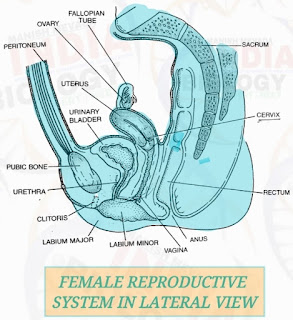STD-12 UNIT-6 CHA-3
HUMAN REPRODUCTION
FALLOPIAN TUBES, UTERUS, VAGINA
FALLOPIAN TUBE (OVIDUCT)
- Each Fallopian tube is about 10-12 cm long and con sists of the following parts .
- The infundibulum is a dilated trumpet - like portion opening into the peritoneal cavity . The end of the tube has finger - like projections called fimbriae which help in collection of the ovum after ovulation.
- The ampulla is the widest and longest part of the Fallopian tube .
- The isthmus is the short , narrow thick - walled portion that follows the ampulla .
- The uterine part passes through the uterine wall and communicates with the uterine cavity .
- Functions of Fallopian Tubes .
- The Fallopian tube conveys the ovum from the ovary to the uterus .
- It is done by peristalsis .
- Fertilization of the ovum generally takes place in the upper portion of the Fallopian tube ( ampulla )
UTERUS ( = Metra or Hystera or Womb )
- The uterus is a hollow muscular and inverted pear shaped structure .
- It lies in the pelvic cavity between the urinary bladder and the rectum .
- It comprises three parts :
- The fundus is the upper dome - shaped part of the uterus above the openings of the uterine parts of the Fallopian tubes .
- Cornua ( sing . Cornu ) . They are the upper corners where the oviducts enter the uterus .
- The body ( corpus ) is the main part which is narrowest inferiorly where it continues with the cervix .
- The cervix is the part which joins the anterior wall of the vagina and opens into it . The cavity of the cervix is called cervical canal .
- The cervix communicates above with the body of the uterus by an aperture called internal os and with the vagina below by an opening , the external os .
- The walls of the uterus are composed of three layers of tissues .
- The perimetrium is an outer thin covering of peritoneum .
- The myometrium is a middle thick layer of smooth muscle fibers which shows strong contraction during delivery of the baby .
- The endometrium is inner glandular layer that lines the uterine cavity .
- The endometrium undergoes cyclical changes during menstrual cycle .
- Functions of Uterus .
- After puberty the uterus goes through the menstrual cycle .
- If the fertilization has taken place , the embryo gets attached to the uterine wall where it is nourished and protected .
- At the end of the gestation period labour begins and concludes when the child born .
VAGINA
- The vagina is a tube , about 10 cm long , that extends from the cervix to the outside of the body .
- It is easily stretched . The opening of the vagina , called the vaginal orifice (vaginal opening ) . is partially covered by a membrane called the hymen
- Functions of Vagina .
- It provides a passageway for the menstrual Now , serves as the receptacle for sperm during intercourse , and forms part of the birth canal during labour







Please do not enter any spam link or word in the comment box